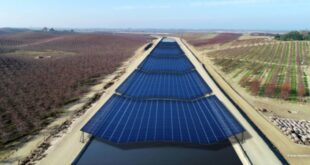Seeking to develop innovative gadgets and concepts for water conservation, students and faculty at California State Polytechnic University, Pomona (Cal Poly Pomona) have undertaken a variety of projects for potential use as Californians cope with five years of unrelenting drought.
According to the university’s quarterly publication, Panorama – for alumni and friends of the school – a team of students have developed a raindrop-shaped device to hang in the shower and provide a simple visual cue for maintaining shorter showers. Motivated to educate people about water scarcity and options to conserve water, the students created Lono Drop Education, as the device is now known, in the university’s Education in STEM Entrepreneurship (ESTEME) Program.
Lono Drop Education is activated by waving your hand underneath the device at the beginning of a shower. Initially the device glows green and changes colors to indicate the elapsed time; when the device flashes red, you have exceeded your allotted time and need to turn off the water and exit the shower. Even young children can understand and operate the device.
Nine students from the colleges of engineering, business administration and hospitality management developed the Lono Drop Education. They estimate the device could allow an individual to save 5,000 gallons of water annually.
Panorama also highlighted the efforts of Mechanical Engineering Department Assistant Professor Maryam Shafahi and her students to help cope with California’s drought and waterways polluted by farm runoff. The group utilized aquaponics –a sustainable food production technology that combines aquaculture (fish cultivation) and hydroponics (water-based planting) – to grow fish and plants together in a symbiotic environment.
“Aquaponics is a closed circle between fish and plants, using fish waste to feed the plants,” said Shafahi, “so you don’t need any chemical fertilizer for the system, and there is no water wasted.”
Shafahi and her students built an aquaponics system at the university’s Lyle Center for Regenerative Studies and grew 250 heads of lettuce and 15 tilapia fish in two large 200-gallon tanks.
In addition to the two conservation innovations, Panorama is also reporting efforts by Jeremy Claisse, an assistant professor of biological sciences at Cal Poly Pomona and a marine ecologist who has been working in conjunction with the U. S. Bureau of Ocean Energy Management (BOEM) to foster the underside of oil rigs as stunning reefs habitats for fish and other ocean wildlife.
Oil rigs, long-known as a blight on a water’s surface, harbor a wealth of pipes, girders and equipment that – oddly enough – are a thriving corner for underwater ecosystems. BOEM awarded Claisse and colleagues a $100,000 grant to study the underside of the oil rigs as fish habitats.
Along with collaborators from the University of California at Santa Barbara’s Marine Science Institute and BOEM, Claisse found that oil rigs are 27 times more productive than natural rock reefs as fish ecosystems off California’s coast. They provide a range of habitats for fish and various invertebrates.
The downside? What to do when the rig is no longer in operation.
“One option is to remove the top portion of the structures to allow for boats to pass, while leaving the rest of the underwater structure to remain as fish habitat,” said Claisse. “This would save the oil companies money, with some of those savings contributing to a trust to fund marine research and conservation. Another option is to remove the platform altogether, which is what the oil companies originally agreed to do, but this would pretty much result in a complete loss of the fish and the habitat.”
Stay tuned — Claisse and his team are continuing their research with a new $40,000 grant from the University of Southern California Sea Grant Program.
 California Water News Daily Your Source For Water News in California
California Water News Daily Your Source For Water News in California


